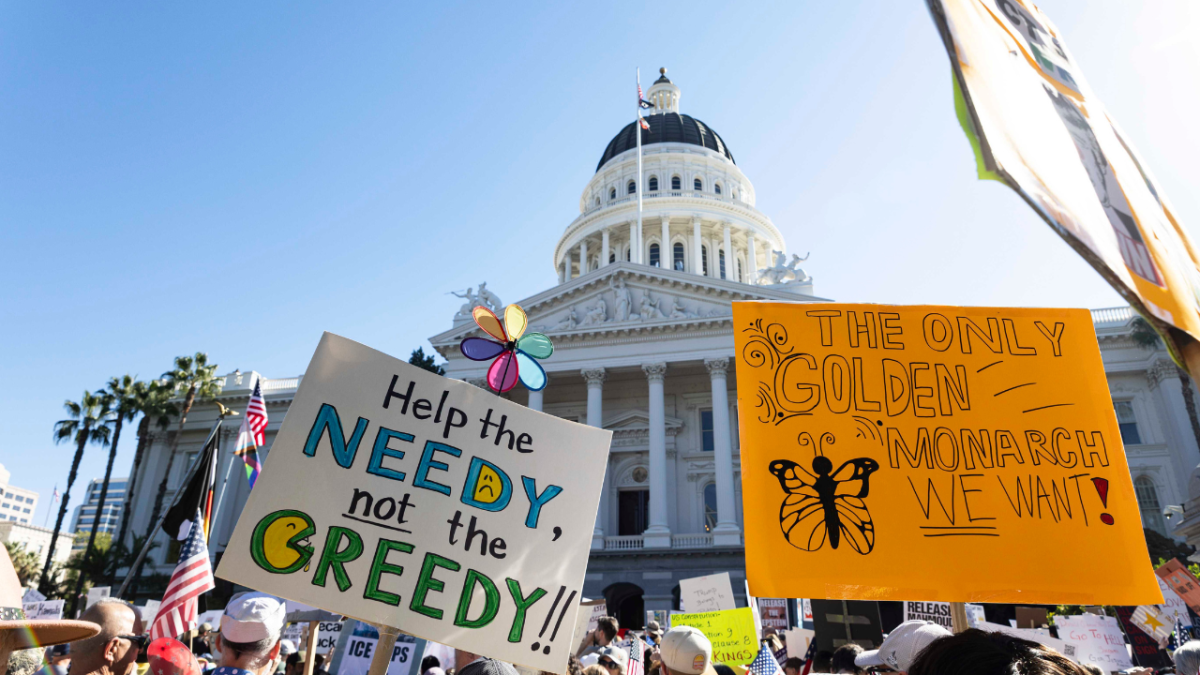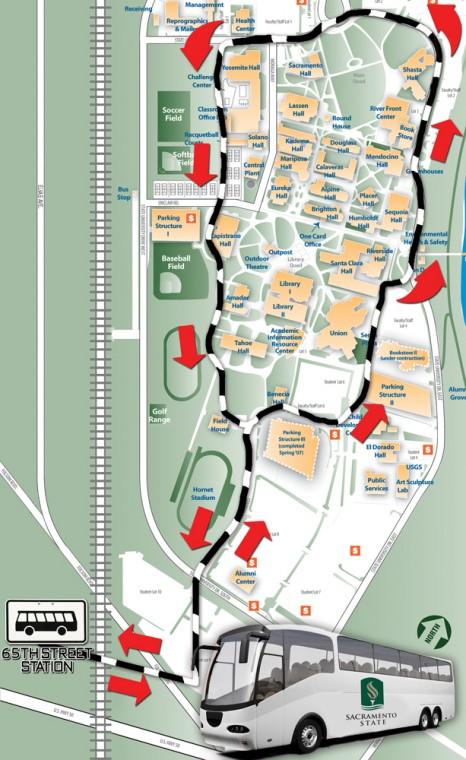Future uncertain for CSUS tram
One proposal for the Sac State tram has is running from the 65th Street light rail station through campus. Under this plan, the tram would run through Serna Plaza on new roads.:
November 21, 2008
The city of Sacramento and Sacramento State have set clean and efficient public transportation as a priority to developing the local community and the campus. One current plan is to extend a tram system from the 65th Street light rail station through the Sac State campus.
Once completed, the tram will offer students, faculty and staff convenient access to campus from other major regional transit services, as well as encourage growth in the Folsom Boulevard and 65th Street neighborhoods.
While no route has yet been decided, a recent route proposal ran through Serna Plaza and separated Yosemite Hall from the tennis courts and sports fields. A fence would separate the roadway from the campus.
Ashley Koren, sophomore psychology major, said a roadway would spoil the Serna Center.
“This part of the campus has a prestigious feel to it,” Koren said. “It is quaint and quiet, even when there are a lot of people around.”
Koren said the idea of a tram to the light rail was a good idea, but the campus should come up with a better way of connecting. Koren suggested using existing roads.
Roy Rodriguez, junior nursing major, said he also felt the tram should be run on existing roads.
“Having the tram run through campus like that will disjoint the students connection to the campus,” Rodriguez said.
University Enterprises, Inc. is organizing the funding and building of the tram. UEI expects the trams to be able to shuttle 3,500 to 5,000 people per day to and from the campus. They will use four or five buses specially designed to be quickly accessible.
“It won’t be a big deal to have four buses driving around,” said sophomore finance major Ambithn Bachan. “It won’t be any different than when we are crossing any other street.”
Kirat Baines, junior nutrition major, said having a reliable connection to the light rail will be worth the risk involved.
“We aren’t kids,” Baines said. “We can watch out for buses.”
The tram initially was predicted to be operating limited routes this year, according to the City of Sacramento’s General Plan 2030.
Alan Porter, senior Sacramento city planner, said the project has not gotten off the ground yet.
“I know that planning of the tram has not been finished,” Porter said.
Sacramento’s city plan is out-of-date in a number of development issues on campus. The plans show the Science II structure, though it is not correctly located on the map. Science II was expected to be completed this year, according to the city plans.
Since Science II was initially designed, both the location and the size of the Science II building have changed. The planned building site is now the staff parking lot next to the new bookstore. Inadequate funding has stalled the project before the designing process was complete.
The tram program has run into similar problems to those of the Science II complex: funding issues from a slow economy and no increase of funding to the CSU system.
Bridget Riley, coordinator of the tram project for the company, said cuts to the budget have pushed the start of construction off by at least a year.
“We are doing a preliminary ridership analysis and the environmental impact reports,” Riley said.
She hopes to have a full report completed by next month.
“There is no decision yet on the route,” Riley said. “We have a few different proposals and concepts we are working with.”
Riley added that nothing was set in stone. The project will require funding for construction and planning, money that is not available in the current budget. The company may know if the project can continue as soon as May 2009.
Funding has come in spurts to the tram project. State and federal grants for construction and planning have totaled $1.7 million. According to the Sacramento Business Journal, the tram project could cost more than $20 million to complete.
UEI and PB Engineering, the firm contracted to work on the project, remain optimistic about having the Sac State portion of the tram completed by 2010.
Cindy Collins, UEI project manager said in an interview with the Sacramento Business Journal, 2010 was an ambitious time line to complete the project.
“We are sticking to it,” Collins said.
Construction of dedicated roadways for the tram around campus are estimated to take one year, according to PB Engineering. Planning could also take a year. Funding is unpredictable, and could tangle the project up for much longer.
Sac State has applied for federal funding totaling $2.4 million. These funds would be applied to purchasing the trams.
The city plans on having the tram as an integral component in an effort to revitalize the community around the 65th Street light rail station. An extension of Ramona Avenue will provide a direct route for trams to reach the light rail station without impeding traffic on Folsom Boulevard.
Construction of this extension could be many years off. The plan will require the excavation of two tunnels, one beneath Highway 50, and the other beneath the Southern Pacific railroad tracks. An existing tunnel, called Hornet’s Crossing, has been deemed inadequate for the purposes of a tram.
Additional construction in the Folsom and 65th Street area will bring mixed-use high-rise buildings and retail shops. City planners are attempting to create a college-town feel with a Midtown look. Plans call for generous sidewalks, street parking, and space for outdoor cafes. The Ramona Avenue extension is being designed as a tree-lined, pedestrian-friendly link to Sac State.
The extension will create a new main entrance to Sac State, labeled the “Green Gateway” in city documents. Currently called Stadium Drive, changes to this road would necessitate accounting for the tram and the increased pedestrian traffic.
Project planners envision a bus-like tram with subway car-style doors. Clean energy buses would reduce emissions in accordance with the Destination 2010 initiative, as well as provide a quiet and convenient transportation system to the campus.
Riley and Porter said planning is continuing on the project, despite a difficult financial future.

























































































































